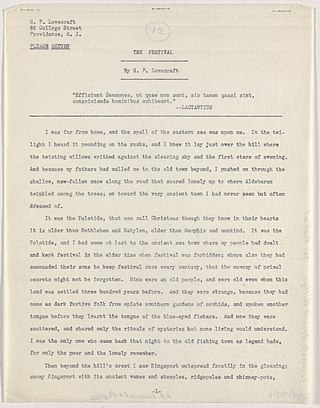
The Necronomicon, also referred to as the Book of the Dead, or under a purported original Arabic title of Kitab al-Azif, is a fictional grimoire appearing in stories by the horror writer H. P. Lovecraft and his followers. It was first mentioned in Lovecraft's 1924 short story "The Hound", written in 1922, though its purported author, the "Mad Arab" Abdul Alhazred, had been quoted a year earlier in Lovecraft's "The Nameless City". Among other things, the work contains an account of the Old Ones, their history, and the means for summoning them.

Robert Albert Bloch was an American fiction writer, primarily of crime, psychological horror and fantasy, much of which has been dramatized for radio, cinema and television. He also wrote a relatively small amount of science fiction. His writing career lasted 60 years, including more than 30 years in television and film. He began his professional writing career immediately after graduation, aged 17. Best known as the writer of Psycho (1959), the basis for the film of the same name by Alfred Hitchcock, Bloch wrote hundreds of short stories and over 30 novels. He was a protégé of H. P. Lovecraft, who was the first to seriously encourage his talent. However, while he started emulating Lovecraft and his brand of cosmic horror, he later specialized in crime and horror stories working with a more psychological approach.

Shub-Niggurath is a deity created by H. P. Lovecraft. She is often associated with the phrase "The Black Goat of the Woods with a Thousand Young". The only other name by which Lovecraft referred to her was "Lord of the Wood" in his story The Whisperer in Darkness.

Henry Kuttner was an American author of science fiction, fantasy and horror.

At the Mountains of Madness is a science fiction-horror novella by American author H. P. Lovecraft, written in February/March 1931 and rejected that year by Weird Tales editor Farnsworth Wright on the grounds of its length. It was originally serialized in the February, March, and April 1936 issues of Astounding Stories. It has been reproduced in numerous collections.

Frank Belknap Long Jr. was an American writer of horror fiction, fantasy, science fiction, poetry, gothic romance, comic books, and non-fiction. Though his writing career spanned seven decades, he is best known for his horror and science fiction short stories, including contributions to the Cthulhu Mythos alongside his friend, H. P. Lovecraft. During his life, Long received the World Fantasy Award for Life Achievement, the Bram Stoker Award for Lifetime Achievement, and the First Fandom Hall of Fame Award (1977).

"The Nameless City" is a short horror story written by American writer H. P. Lovecraft in January 1921 and first published in the November 1921 issue of the amateur press journal The Wolverine. It is often considered the first story set in the Cthulhu Mythos world. In the story, the protagonist travels to the middle of the Arabian Desert to explore an ancient underground city.

"The Haunter of the Dark" is a horror short story by American author H. P. Lovecraft, written between 5–9 November 1935 and published in the December 1936 edition of Weird Tales. It was the last written of the author's known works, and is part of the Cthulhu Mythos. The epigraph to the story is the second stanza of Lovecraft's 1917 poem "Nemesis".
Unaussprechliche Kulte is a fictional book of arcane literature in the Cthulhu Mythos. The book first appeared in Robert E. Howard's 1931 short stories "The Children of the Night" and "The Black Stone" as Nameless Cults. Like the Necronomicon, it was later mentioned in several stories by H. P. Lovecraft.
De Vermis Mysteriis, or Mysteries of the Worm, is a fictional grimoire created by Robert Bloch and incorporated by H. P. Lovecraft into the lore of the Cthulhu Mythos.

"In the Walls of Eryx" is a short story by American writers H. P. Lovecraft and Kenneth J. Sterling, written in January 1936 and first published in Weird Tales magazine in October 1939. It is a science fiction story involving space exploration in the near future.

"The Festival" is a short story by H. P. Lovecraft written in October 1923 and published in the January 1925 issue of Weird Tales.
"Jerusalem's Lot" is a short story by Stephen King, first published in King's 1978 collection Night Shift. The story was also printed in the illustrated 2005 edition of King's 1975 novel 'Salem's Lot.
"Polaris" is a fantasy short story by American author H. P. Lovecraft, written in 1918 and first published in the December 1920 issue of the amateur journal The Philosopher. It is the story that introduces Lovecraft's fictional Pnakotic Manuscripts, the first of his arcane tomes.
"The Black Stone" is a horror short story by American writer Robert E. Howard, first published in the November 1931 issue of Weird Tales. The story introduces the mad poet Justin Geoffrey and the fictitious Unaussprechlichen Kulten by Friedrich von Junzt. The story is part of the Cthulhu Mythos, and follows the same pattern and has the same features as much of H. P. Lovecraft's classic work.

"Hypnos" is a short story by American horror fiction writer H. P. Lovecraft, penned in March 1922 and first published in the May 1923 issue of National Amateur.
"I, Cthulhu" is a short humorous story by fantasy author Neil Gaiman featuring H. P. Lovecraft's Cthulhu, who is dictating an autobiography to a human slave named Whateley. The story reveals much about Cthulhu's 'birth' and early life.

De Vermis Mysteriis is the sixth studio album by American heavy metal band High on Fire. Cover art was done by tattoo artist Tim Lehii.












